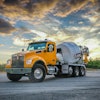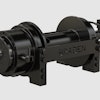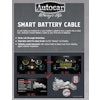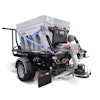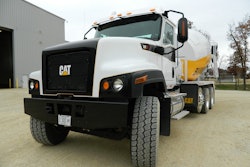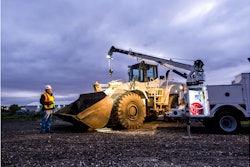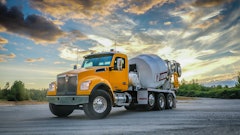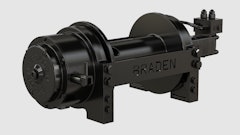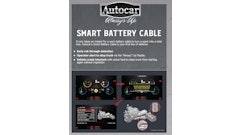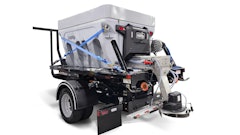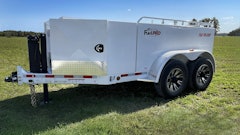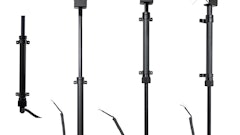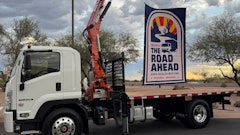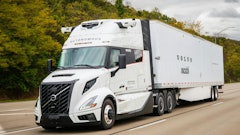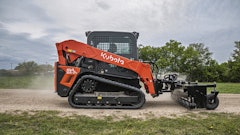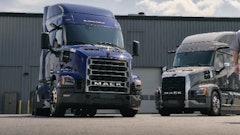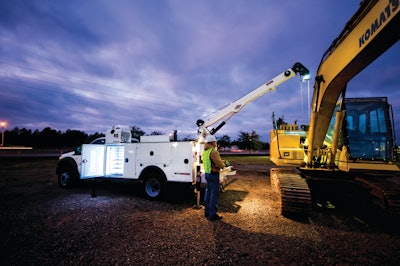
A mechanics truck is among the most useful tools in your technician’s arsenal, but it needs to be set up correctly to enhance productivity rather than hinder it. A common mistake is cutting corners to save on acquisition cost.
“Many people under spec the engine horsepower. They may under spec the interior,” says Tim Davison, product manager, bodies and cranes, Stellar Industries. “They think, ‘As long as it gets down the road to the next job, I’m okay.’ But when you pull maximum torque out of your engine day in and day out, that truck engine is not going to last as long.”
And the mechanic probably won’t be happy with the truck. “If they don’t like the truck, they are not going to service it very well,” says Davison. “That is human nature.”
When spec’ing the vehicle, start with the work that must be performed. “Determine what loads need to be lifted/transported, and what tools need to be stored on the service truck,” says Nathan Schiermeyer, engineering manager, Maintainer. “After that, the size of crane and body need to be determined, along with what type of chassis (GVWR, CA, length, etc.).”
Starting with the truck chassis can be a costly mistake. “Sometimes, customers have already selected or purchased the favorite chassis,” says Tom Wibben, sales and service manager at Maintainer. “We do our best to give them a great product, but sometimes the equipment that can be installed is limited by the chassis selection.” In some cases, owners purchase a chassis with the goal of staying under the CDL limit (26,000 lbs.). This can make it difficult to install additional equipment.
Conversely, if you size the truck for the maximum lift you may ever do, it will likely be oversized. “The truck needs to be sized to handle all the required jobs, but oversizing results in wasted investment, additional fuel consumption and higher ongoing licensing fees,” says Schiermeyer.
Examine Specific Requirements
A thorough understanding of each technician’s tool requirements will help you select the right-sized mechanics trucks.
“Not every truck may require a welder or have the same air system requirements,” says Terry Cook, product manager of commercial products, Iowa Mold Tooling Co. (IMT). “Some technicians may need fewer hand tools but utilize heavier items such as a welder. The need for a lot of tools may drive a contractor to a larger body even though a smaller crane is required. Analysis of utilization and operation/maintenance costs should help in this decision.”
He adds, “One overarching point to remember is that mechanics truck specifications are highly interdependent. Lifting needs dictate crane size, which governs the size of the body. Crane size, body size and required payload combine to decide the size of the chassis. The required tools included on the truck, combined with other air needs, will determine whether a rotary screw or reciprocating air compressor is added.”
Also consider the weight of components and products you intend to carry in the bed. “Technicians usually will not hit that overload stage until they start hauling components,” says Davison. “This is especially true now that many trucks are starting to carry lube skids to perform preventive maintenance. The engine or lube skid may occasionally push the truck to or above its maximum GVWR.”
Load balance is also an important consideration. “Load distribution front-to-back and side-to-side is often overlooked and can impact drivability of the truck,” says Davison.
Cranes often dictate the sizing criteria. “If a crane is going to be utilized on the truck, then it all starts with the capacity and reach of the crane,” says Craig Bonham, vice president of sales, Reading Truck Body Mfg. “That drives the size of the body necessary, in addition to the minimum GVWR and GAWR requirements and strength capacities that need to be in the chassis frame.”
Closely examine your crane needs. “The crane should be sized to accommodate the largest required lift,” says Schiermeyer. Don’t consider just the maximum load that will be picked, but what loads will be lifted at what required distance from the crane.
He adds, “Load charts and foot-pound ratings of the crane need to be carefully considered before selecting the appropriate crane and truck. It is the job of the crane operator to make sure the loads being lifted don’t exceed the load chart maximums, although all Maintainer cranes come with automatic overload protection devices that prevent unintentional overloading.”
Know Component Weights
“Understanding what you lift in your normal course of business is crucial,” says Davison. Most grossly underestimate what components actually weigh.
Davison cites a customer who claimed his crane couldn’t lift a 4,000-lb. engine that was within the crane’s capacity rating. “I scheduled a visit and I brought an electronic scale with me,” he recalls. The engine weighed close to 5,500 lbs., almost 1,500 lbs. more than the customer believed. The weight the customer was using was for a short block. “It didn’t include the manifolds. It didn’t include the bell housing. It didn’t include the oil.”
Bonham has had the same experience. “Many times, people will say they need an 8,000-lb. crane, but they are trying to retrieve a 10,000-lb. component,” he notes.
Constantly running a crane at maximum capacity can shorten life. “If you constantly use it close to its maximum capacity, things are just going to wear out faster,” says Davison. “The wear pads wear out faster because you have more weight on them on a normal basis. You may have to change out the seals on the cylinders faster because they are always running close to that maximum pressure.”
To address this issue, Stellar offers Crane Dynamics Technology (CDT), which provides feedback to the operator when the crane approaches 80%, 90% and 100% of rated capacity. Three LEDs on the handset and vibration in the handle indicate the percent of rated capacity achieved. The CDT also helps to educate customers about a component’s actual weight.
Such systems can be helpful to avoid overloading the crane. However, Cook comments, “While all IMT telescopic cranes incorporate an Excessive Load Limit System to protect the structural components of the crane, longer life can be achieved by choosing a crane that will not be operating at its maximum capacity for the majority of your lift.”
Is the Frame Up to the task?
The chassis frame must be capable of handling the loads placed on it through the mechanics body. “The minimum RBM frame requirements are always listed in the crane body manufacturer’s literature,” says Bonham. “Depending upon the crane being installed, it will tell you the minimum RBM that is necessary to support that crane with the reach and radius it intends to work in.”
“The minimum frame requirements will be determined by the body and crane combination selected,” says Cook. “Frame RBM and section modulus must both be considered when making this selection.”
“Typically, the larger the crane, the larger the RBM that the chassis will require,” says Schiermeyer. “Maintainer designs its service bodies and sub-frames to support the crane loads of all of the most common chassis frames.”
If you’re looking at a used chassis, make sure the frame has not been altered. “We always go back to fully understand what the factory specifications are in relation to RBM without any alteration to that chassis,” says Bonham. “We cannot certify something with any alteration or reinforcement because we don’t know what temper has been put into the steel of the reinforcement.
“There are a lot of things that come into play when you add reinforcements,” he continues. “Typically, Reading Truck Body would prefer to install a mechanics body that fits a crane on a chassis that has a certifiable RBM, manufactured with continuous and predictable RBM from head to toe.”
Verify Clean Back of Cab
A clean back of cab and clean frame rails continue to be important, with different items to consider depending upon chassis size.
“Class 6 and above chassis can have vertical exhaust, oversized fuel tanks or DEF tanks that extend behind the cab and create mechanics body interference,” says Cook. “The position of the DEF tank sometimes makes installation on chassis below Class 6 a challenge and will need to be considered.”
“Nearly all of the Class 6 and above trucks still can have issues with clean back of cab,” says Schiermeyer. “Special care must be taken when ordering chassis to make sure a clean CA is maintained, or a gap is accommodated for with the wheelbase.”
Installations on low-cab forward trucks can be a challenge. “They have automatic transmission coolers that often come into interference,” notes Bonham. They have DEF tanks, air-to-air heat exchangers, exhaust systems and snorkels to help control the engine’s air management system and battery boxes that commonly interfere. This can make the installation quite cumbersome. The low-cab foward configuration allows very little additional room to place these products. However, they can be advantageous in congested areas given the tight turning radius.
Used trucks can also prove challenging. “That is where the problems happen most often,” says Davison. “A guy finds a great deal on a truck and wants you to put a mechanics body on it.” For example, the exhaust, batteries and DEF tank are in the way and an extra-large fuel tank hangs 18 in. behind the cab. “He got a great deal on a chassis that was meant for a van box.”
Inspect the chassis and make sure the fuel tank is under the front steps, not in the rear, and the DEF tank and fill location are not going to interfere. “It is always best never to assume,” says Bonham. “A body builder’s guide is a great tool to determine any interference.”
There are many opinions about what type of suspension system works best on a mechanics truck. Many prefer the reliability of a mechanical suspension, while others tout the shock-absorbing ability of air suspension systems to prolong component life. Therefore, deciding between these systems is a choice best left to you and the provider of the mechanics truck body.
“Both air and mechanical spring suspension systems work well with mechanics trucks if the correct configuration is chosen when selecting your chassis,” says Cook. “When choosing mechanical suspension systems, it is often necessary to install additional leaf springs or spacer blocks to level the unit due to the additional weight of the crane on one side.”
He adds, “With an air suspension system, this is accomplished using dual leveling valves. This is an option that must be added, as most chassis only have a single leveling valve to raise or lower the rear suspension to accommodate loading. A chassis air system dump valve is also required so that the air bags can be de-pressurized during crane operation to ensure proper unit stability.”
Past History vs. Future Needs
Consider your past mechanics truck experience along with future needs when spec’ing a new vehicle.
“The biggest question you need to answer is: what would you like on your next generation product that you don’t have on your current generation product?” says Bonham.
“When I look back at features that customers wish they had or want to add later, a few things come to mind,” says Wibben. “Exterior lighting is one consideration, especially if a mechanic mostly does day service now but adds more night service work down the road. Safety features are another component we promote. Safety lighting, backup cameras and alarms and three-point climbing apparatus are all becoming more popular.”
Another feature sometimes overlooked is roll-out tray and drawer storage. These systems can help keep your ‘shop on wheels’ organized and efficient. The design of the drawers is important. For example, Maintainer offers DuaLock drawers that lock in the closed and open position in case you can’t park on level ground.
“An air system that is properly sized is another consideration,” says Wibben. “The customer must know their business so they can anticipate current and future needs.”
Look at where your business is now and where it will be one, two or three years down the road. “We find businesses are becoming more diverse with the services they offer,” says Bonham. “This can change the dynamics of how a mechanics truck is utilized on your jobsite.”
Service bodies often last a long time and are moved onto one or more chassis over the years. “The longer the life of the service body/crane, the lower the overall cost of ownership becomes, even if it starts out at a slightly higher initial purchase price,” says Schiermeyer.
“The customer must have a vision as to where their business may grow over the years and make a selection accordingly,” says Wibben. “The trend in the industry is still toward larger and larger equipment, so a contractor needs to have a service truck that can handle that equipment.”

